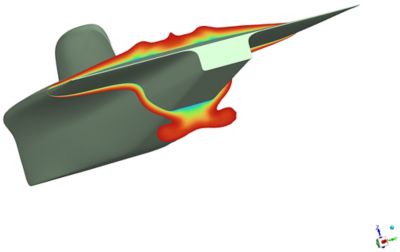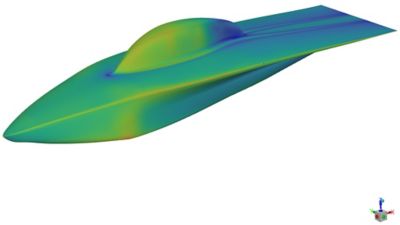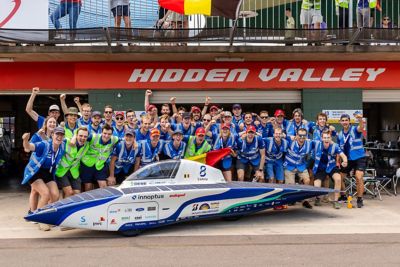-
United States -
United Kingdom -
India -
France -
Deutschland -
Italia -
日本 -
대한민국 -
中国 -
台灣
-
Ansys is committed to setting today's students up for success, by providing free simulation engineering software to students.
-
Ansys is committed to setting today's students up for success, by providing free simulation engineering software to students.
-
Ansys is committed to setting today's students up for success, by providing free simulation engineering software to students.
-
Contact Us -
Careers -
Students and Academic -
For United States and Canada
+1 844.462.6797
ANSYS BLOG
February 21, 2024
Belgium Students Repeat Bridgestone World Solar Challenge Win
For the second time in a row, students from the Katholieke Universiteit Leuven (KU Leuven) in Belgium earned first place at the 2023 Bridgestone World Solar Challenge (BWSC). The competition challenges students from around the world to design, engineer, and race solar-powered vehicles in a 3,021-kilometer route spanning Australia, from Darwin to Adelaide. The competition is normally held every two years, but it experienced a four-year gap between 2019 and 2023 due to the cancellation of the 2021 BWSC during the COVID-19 pandemic.
Consisting of 33 members, KU Leuven’s Innoptus solar team took home the recent win after designing and developing their solar-powered vehicle, Infinite, for about a year. Innoptus members, ranging in age from 21 to 24, include engineering students from industrial, civil, and business disciplines.

The Innoptus solar racing team from Katholieke Universiteit Leuven (KU Leuven) in Belgium celebrate first place at the 2023 World Solar Challenge.
With access to Ansys simulation through a student team partnership under the Ansys Academic Program, Innoptus developed a futuristic, sailing-inspired fin design for Infinite. The partnership provides student teams with free research software and support. Leveraging Ansys simulation to analyze aerodynamics using computational fluid dynamics (CFD), structural integrity, and electromechanical components, Innoptus sailed across the finish line 48 minutes faster than their 2019 win.

Infinite features a futuristic fin that can be deployed in crosswinds to accelerate speed and reduce energy consumption.
Simulating for Sun-powered Speed
Innoptus employed various Ansys tools, including Ansys Mechanical finite element analysis (FEA) software, Ansys Fluent CFD simulation, Ansys SpaceClaim 3D modeling, and Ansys Maxwell electromechanical device analysis software.
The team utilized Mechanical for the structural design of the car chassis and Fluent to analyze fluid and aerodynamic behavior throughout the vehicle. SpaceClaim was mostly used to prepare geometry and create detailed 2D and 3D models, while Maxwell was used for the design and configuration of the magnet array of the motor. In addition, the team used Mechanical and Fluent to simulate the car in different angles of wind and increase its stability in windy conditions, which was useful in perfecting the innovative fin concept.

The dynamic simulation of flow lines reveals the car's aerodynamic prowess, showcasing intricate patterns that minimize drag through fluid dynamics, ultimately enhancing overall aerodynamic efficiency.
For Innoptus, the idea of sailing in car racing was not new. The Bluepoint — their 2019 car — used the principle in a different way. That car had four-wheel steering, which made crabbing, or crab-walking, possible. With this type of steering, rear wheels can mimic the front wheels up to a certain degree and angle, allowing diagonal movement. The design increased the vehicle’s stability in crosswinds, but after the 2019 competition, the BWSC prohibited teams from using the principle. Hence, the idea of a fin was born, and Innoptus developed an early version in 2022 for testing.
“After the success of 2022 with the fin and extra validation in wind tunnels coupled with Ansys software, we decided to further work this concept out,” says Thomas Declercq, Innoptus solar team member and head of marketing. “One week before the race this year, we revealed our secret weapon to the competition: a larger fin than before, with the ability to actively control the rotation of our fin. The advantage of this ability is creating a wider range of application so that we were able to use the crosswinds more effectively to our advantage, compared to our competition.”

Analyzing airflow around specific car zones reduces energy losses and enhances overall design efficiency, optimizing performance on the road.
Infinite features three wheels and an aerodynamic and sleek design at 5 m long (the maximum length allowed by BWSC), 1.2 m wide, and 1 m tall without the fin. The attached 0.4-m fin, which is situated on top of the car’s cockpit, is based on a National Advisory Committee for Aeronautics (NACA) airfoil profile. It can be deployed in crosswinds, enabling the car to move more smoothly and consume up to four times less energy.
Teams are allowed to start the race with a full battery pack charge. Innoptus worked diligently on their self-designed battery pack, which enables Infinite to travel up to 900 km without relying on solar energy.

Shear stress analysis plots guide the aerodynamic design process, contributing to a balanced and efficient vehicle by scrutinizing and adjusting surface curvature.
Rising to the Challenge, Again
Innoptus integrated Ansys simulation into development when their partner and vehicle namesake, Infinite Simulation Systems — who is also an Ansys Elite Channel Partner — introduced the team to the Ansys Academic Program.
Ansys’ simulation and high-performance computing (HPC) capabilities proved invaluable to Declercq and teammates, especially when finding a compromise between efficient aerodynamics and optimal solar panel capacity.
“For aerodynamics, we would like the solar panel surface to be as low as possible, but energy-wise we want it to be as big as possible — limited by the rules,” he says. “With Ansys’ simulation and HPC, we could iterate our design many times over. Because of this, we could test more designs than we would have been able to with just ‘normal’ computing, and we were better able to make an educated decision.”

Current two-time BWSC champions, the Innoptus solar racing team has been building solar cars since 2004.
The competition generally runs up to two weeks, including seven days for the main race and around five days for scrutineering — preliminary rounds that consist of mechanical and electrical inspections as well as dynamic tests, such as U-turns and figure-eight maneuvers.
As part of the inspections, judges also assess road legality. Just like a regular road vehicle, each car has indicators, other lighting systems, seat belts, and a horn that need to be inspected. For safety, drivers are also tested for egress, which requires that the driver is able to get out of the car in 15 seconds or less in case of emergency. Innoptus was the first team to pass this year’s scrutineering rounds.
For the main event, three drivers switched off every two to four hours and drove daily from around 8 a.m. to 5 p.m.
Innoptus has often said that they don’t build cars just for the fun of it. They build solar cars to showcase the power of green energy and to prove that Belgian technologies are at the forefront of innovation. Now, as two-time BWSC champions, they have demonstrated this once again.
To learn more about Innoptus, visit their website. For more information about Ansys’ support of student teams, browse the Ansys Student Team Partnerships Guide and request a partnership.











